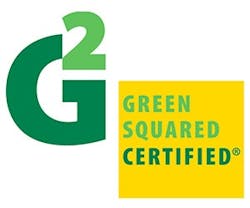How sustainable are ceramic and glass tiles? Whether used for durability or decoration, tiles in lobbies, corridors, pool areas, restrooms and professional kitchens are an opportunity to specify products that are environmentally responsible. Learn how Green Squared, a multi-attribute certification, ensures that tiles and related installation materials are green from start to finish.
It’s Hip to Be Squared
Made from inorganic materials, tiles don’t usually come to mind as an environmental offender. But just because something isn’t harmful doesn’t mean that it’s sustainable. Spearheaded by the Tile Council of North America (TCNA), Green Squared is the result of industry consensus and formalized as ANSI A138.1.
The standard applies not only to ceramic and glass tiles, but also to all installation materials: “powder goods (grouts, mortars), panel installation products (backer boards, underlayments), liquid and paste installation products (trowelable membranes, polymer additives) and sheet installation products (crack isolation and waterproof membranes).”
This comprehensive scope ensures that all aspects of a tile project have been vetted for eco-friendly qualities.
Green Squared is the only such standard for the tile industry, says Bill Griese, TCNA’s Director of Standards Development and Sustainability Initiatives. Manufacturers seeking the label must go through a third-party certification with UL Environment, NFS International or SCS Global Services. This authentication step is why the standard is commonly recognized by major building certification programs, Griese adds.
As a multi-attribute label, Green Squared doesn’t focus on only one criteria to assert a product is green.
“Sustainability can be tricky to define – how do you decide what is most important? For example, is low or no VOCs better than having recycled content?” asks Griese. “As the experts for these products, the tile industry saw a real need to define what is most important for sustainability. To have a true multi-attribute standard, you can’t look at ingredients, the use phase or manufacturing alone – you have to consider the full lifecycle.”
Ecological Criteria
Green Squared covers five areas of environmental responsibility: product characteristics, manufacturing, end of product life management, corporate governance and innovation. Each of these areas have prerequisites to achieve, with elective points for going above and beyond, Griese explains.
Product Characteristics – This category addresses raw materials and packaging, including recycled content, level of volatile organic emissions and the amount of indigenous materials. For example, all tiles must be no VOC but installation products can be low VOC.
Companies must also demonstrate that their packaging is “minimal, biodegradable or compostable (in accordance with ASTM biodegradability criteria), recyclable, reusable on-site, or has recycled content.”
Manufacturing – Environmental responsibility is further emphasized during the production process, says Griese, including disclosure of materials and sustainable procurement policies. Factory safety is also addressed by prohibiting visible particulate matter emissions, which can cause health problems.
Fuels are limited to natural gas, LP, landfill-generated methane, or biobased sources. The standard also requires companies “to have an environmental management plan that addresses waste minimization, lighting efficiency, heating fuel usage, electricity consumption and water conservation.”
Reuse and Recycle – Tiles are unlikely to wear out like other flooring options, but in the event they ugly out, Green Squared ensures they can be reused or recycled safely.
One option for compliance is to have materials meet the EPA's clean fill definition, which means they are non-water soluable, inert and can’t decompose. This puts them into a class with rocks, bricks and concrete – solid materials that won’t leach caustic liquids.
“The standard also awards points if the tiles can be reused in other products, such as ground up into asphalt mix, or the producer offers a takeback program,” Griese notes.
Corporate Governance – Most environmental standards are focused on the product itself but Green Squared requires that a company’s manufacturing and business practices exhibit the same sense of accountability, explains Griese.
The standard also includes a fifth area for innovation, rewarding points for using creative manufacturing practices and adopting cutting-edge technologies.
Sturdy and Sustainable
The days of trading off green qualities for practical performance are long gone for this class of products. But in case you have any doubts, know that all Green Squared items must meet the durability requirements as outlined in ASNI A138.1.
Crossville, which certifies its offerings, appreciates how a product’s environmental profile is clearly outlined for specifiers looking to make green choices.
“Owners can take comfort that they’re placing a product into their building that complies with a green standard and is produced by a responsible manufacturer,” says Noah Chitty, Crossville’s Technical Services Director. “Tiles are also guaranteed to meet a certain minimum level of performance; without a standard, you’re just
buyer beware.”
“Green Squared takes all the concerns throughout the supply chain – efficient manufacturing, product performance, low maintenance and sustainability – and addresses them in a single, transparent standard,” Griese adds. “The standards developers have done the work for you.”
Jennie Morton [email protected] is Senior Editor of BUILDINGS.
About the Author
Jennie Morton
A former BUILDINGS editor, Jennie Morton is a freelance writer specializing in commercial architecture, IoT and proptech.
